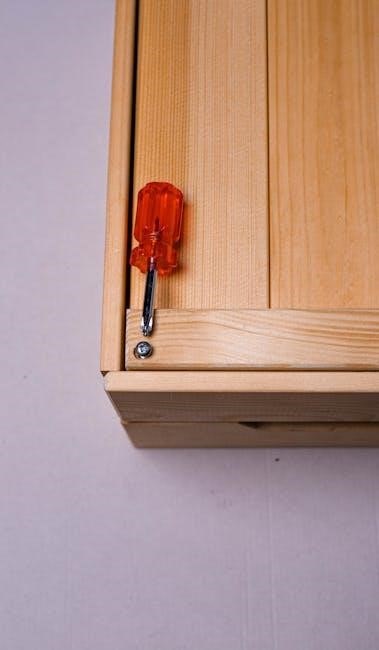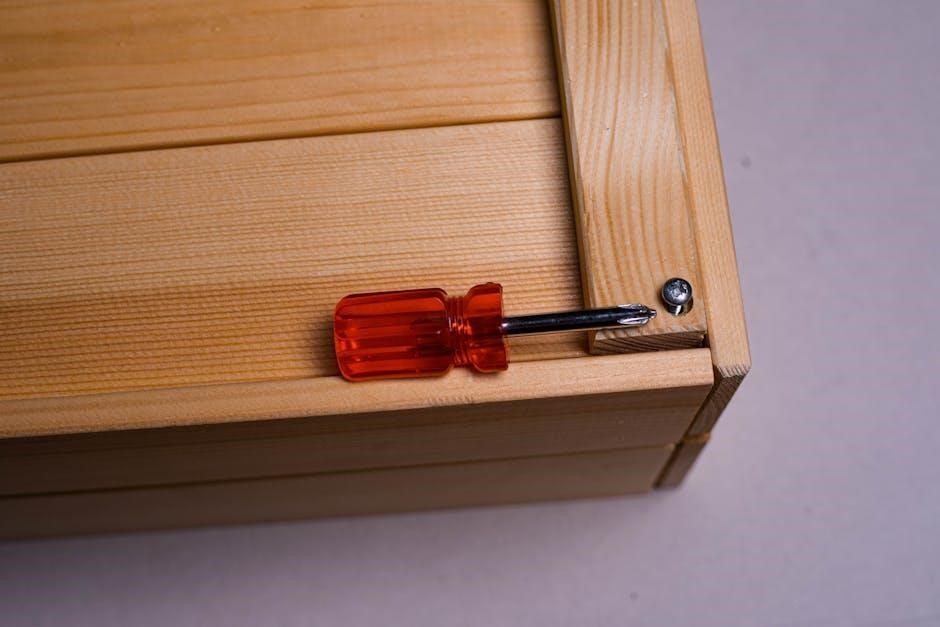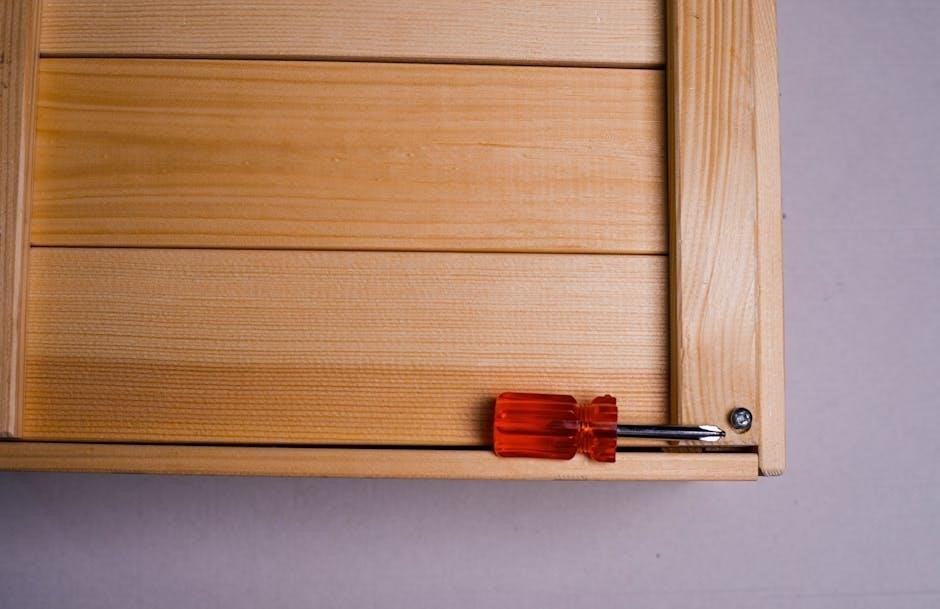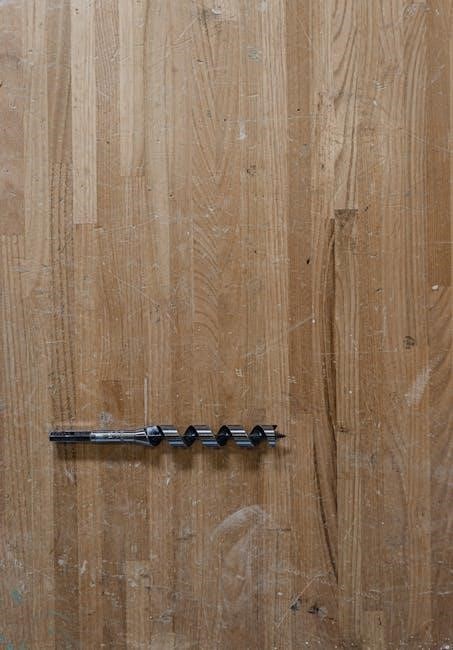wood screw size chart pdf

Wood Screw Size Chart PDF: A Comprehensive Guide
Wood screw size charts in PDF format are essential resources for woodworking projects. These charts provide crucial dimensions, including nominal size, length, and head type, ensuring proper screw selection. They often cover imperial and metric sizes to facilitate accurate matching for various applications.
Wood screws are fundamental fasteners in woodworking, designed specifically for joining pieces of wood or attaching hardware to wood. They feature a sharp point and aggressive threads, enabling effective penetration and strong gripping. Understanding wood screw dimensions, including length and gauge, is crucial for selecting the correct screw for a particular application. Wood screws are available in various materials, such as steel, often with coatings for corrosion protection.
Size charts provide detailed specifications, aiding in the selection of appropriate drill bit sizes and ensuring proper installation. These charts typically include information on different head types, such as flat and round, and their corresponding dimensions.

Understanding Wood Screw Dimensions
Grasping wood screw dimensions involves understanding nominal size, gauge, and length. Accurate measurement conventions are essential for selecting the right screw for a secure and effective woodworking joint or hardware attachment.
Nominal Size and Gauge
Nominal size in wood screws refers to a numerical designation indicating the screw’s approximate diameter. The gauge, often expressed as a number from 0 to 20, further specifies the screw’s thickness. Larger gauge numbers correspond to thicker screws, providing greater holding power. Understanding the relationship between nominal size and gauge is crucial for selecting screws appropriate for different wood densities and project requirements. For instance, a smaller gauge screw might be suitable for softwood, while a larger gauge screw is preferable for hardwood. Always consult a wood screw size chart to ensure accurate selection based on the specific application.
Length Measurement Conventions
Length measurement in wood screws depends on the head type. For flat or countersunk head screws, the length is measured from the top of the head to the screw’s tip. Conversely, for round or pan head screws, the length is measured from the underside of the head to the tip. This distinction is crucial to ensure proper screw penetration and secure fastening. Inaccuracies in length measurement can lead to screws protruding or failing to achieve adequate grip. Always refer to a detailed wood screw size chart that illustrates these conventions clearly to avoid errors during project execution. Precise measurement ensures optimal joint strength and aesthetic appeal.

Wood Screw Head Types and Dimensions
Wood screw heads vary significantly, each suited for specific applications. Common types include flat, round, and oval heads. Dimensions for each type, like diameter and height, are critical for proper countersinking and flush mounting, impacting the final finish.
Flat (Countersunk) Head Dimensions
Flat (countersunk) head screws are designed to sit flush with the surface of the material, offering a clean, unobtrusive finish. These screws require a countersunk hole to accommodate the head, ensuring it doesn’t protrude. Key dimensions include the head diameter, head angle, and overall head thickness. According to ANSI B18.6.1, knowing the head diameter (max and min), head height and recess dimensions are critical for proper installations.
Flat head dimensions are usually provided in wood screw size charts, specifying the maximum and minimum values for accurate drilling and countersinking. A flat head screw with countersunk 90º head is often used in chipboard applications. Proper dimension adherence ensures optimal screw performance and aesthetic appeal in woodworking projects.
Round Head Dimensions
Round head wood screws feature a domed, half-spherical shaped head that sits above the surface of the material. Unlike flat heads, round heads do not require countersinking, making them suitable for applications where a slightly raised profile is acceptable or even desired. According to ANSI B18.6.1, important dimensions include the head diameter and head height.
Wood screw size charts provide detailed measurements of these dimensions, specifying the maximum and minimum values to ensure proper fit and function. These charts help users select the correct screw size to achieve the desired aesthetic and structural integrity.

Wood Screw Materials and Coatings
Wood screws are made from various materials, including steel, brass, and stainless steel. Coatings like zinc plating enhance corrosion resistance. Material hardness and strength are crucial for performance in different wood types and applications, ensuring durability.
Corrosion Protection Standards
Corrosion protection is vital for wood screws, especially in environments exposed to moisture. Standards like DIN SPEC 1052-100:2013 and EN 14592:2022 outline minimum requirements for corrosion resistance in wood construction screws. For screws with a nominal diameter of 4 mm or less, no protection is needed in service classes 1 and 2, according to EN 1995-1-1, Table 4.1. Zinc plating is a common method, providing a protective layer that prevents rust. Selecting the right coating ensures longevity and reliability in various applications, maintaining the structural integrity of wood assemblies over time.
Material Hardness and Strength
The material hardness and strength of wood screws are critical for ensuring secure and lasting connections. AFT Fasteners highlights the importance of these properties, which directly impact a screw’s ability to penetrate wood and resist breaking under stress. Screws are often made from steel, with varying degrees of hardness depending on the application. Hardened steel screws are preferable for hardwoods, while softer screws may suffice for softwood. Coatings like zinc can affect hardness, and understanding these material characteristics helps in selecting the appropriate screw for optimal performance and durability in diverse woodworking projects.
Drill Bit Size Recommendations
Selecting the correct drill bit size is crucial for successful wood screw installation. Pilot holes prevent wood splitting and ensure proper screw engagement. Size charts provide specific drill bit recommendations for various screw sizes and wood types.
Drill Bit Sizes for Softwood
When working with softwood, selecting the appropriate drill bit size is critical to prevent splitting and ensure a secure hold. Softwoods, being less dense than hardwoods, require a slightly smaller pilot hole. The goal is to allow the screw threads to grip the wood without excessive force.
Consulting a wood screw size chart PDF is highly recommended, as it typically includes specific drill bit recommendations for softwood based on the screw’s gauge. Using the correct drill bit ensures the screw can effectively penetrate and grip the wood, creating a strong and reliable joint.
Drill Bit Sizes for Hardwood
Selecting the correct drill bit size for hardwood is essential to avoid snapping screws and ensure proper fastening. Hardwoods, due to their density, require a pilot hole that allows the screw to pass through without excessive resistance. A wood screw size chart PDF typically provides drill bit recommendations tailored to hardwood.
Using a drill bit that is too small can cause the screw to break or strip the wood, while a bit that is too large reduces the screw’s holding power. Always refer to the chart for optimal drill bit selection.
Specialty Wood Screws
Specialty wood screws, such as self-drilling and chipboard screws, cater to specific applications. Self-drilling screws eliminate pre-drilling, while chipboard screws are designed for particleboard. Selecting the correct specialty screw ensures optimal performance and joint integrity.
Self-Drilling Screws
Self-drilling screws, also known as self-tapping screws, are designed to eliminate the need for pre-drilling pilot holes in wood or other materials. These screws feature a drill-bit-shaped point that drills its own hole as it is being installed. This feature saves time and effort, making them ideal for applications where speed and efficiency are crucial. Self-drilling screws are commonly used in woodworking, construction, and metalworking.
They are particularly useful when working with hardwoods or when installing screws in difficult-to-reach areas. The drill point ensures accurate screw placement and prevents the wood from splitting. Some self-drilling screws also include features like thread-cutting capabilities, further enhancing their versatility.
Chipboard Screws
Chipboard screws are specifically designed for use with particleboard and other composite wood materials. These screws typically have a thin shank and deep, sharp threads that provide excellent grip in the relatively soft and fibrous chipboard. This design prevents the screw from stripping or loosening over time, ensuring a strong and durable connection.
Chipboard screws often feature a countersunk head, allowing them to sit flush with the surface of the material. They are commonly used in furniture assembly, cabinet making, and other applications where chipboard is the primary material. Selecting the correct size and type of chipboard screw is crucial for achieving optimal results.
Using Wood Screw Size Charts Effectively
Wood screw size charts are invaluable tools, but understanding how to use them effectively is crucial. Always start by identifying the materials you’re joining and the desired holding power. The chart will guide you to the appropriate screw gauge and length based on the material thickness. Pay close attention to the head type; flat heads are ideal for countersinking, while round heads offer a more decorative finish.
Consider the screw’s material and coating for corrosion resistance, especially in outdoor or damp environments. Properly interpreting the chart ensures you select the right screw for a secure and lasting connection, minimizing the risk of splitting or stripping the wood.
Pocket Hole Screw Selection
Selecting the correct pocket hole screw is vital for strong and seamless joints. The wood thickness dictates the screw length, preventing protrusion or weak connections. Use a pocket hole screw selection chart to match the wood thickness with the appropriate screw length accurately.
For example, a chart from Kreg provides a depth guide. Finer threads work best for hardwoods, while coarser threads excel in softwoods, ensuring optimal grip. Also, consider using self-tapping screws. The correct screw prevents pull-through and ensures the joint’s integrity. Proper selection guarantees a clean, professional finish, enhancing the project’s overall quality and durability.
Imperial vs. Metric Wood Screw Sizes
Understanding the differences between imperial and metric wood screw sizes is essential. Metric screws follow DIN standards, like DIN 97, while imperial sizes use gauges and inches. Charts help convert and compare effectively.
Metric DIN Standards (e.g., DIN 97, DIN 7997)
Metric wood screws often adhere to DIN standards, ensuring consistent dimensions and quality. DIN 97 specifies slotted flat countersunk wood screws, ideal for attaching wood or hardware. These screws feature a self-tapping thread for effective penetration.
DIN 7997 covers Phillips flat countersunk head wood screws, also used for joining wood. These screws offer similar self-tapping capabilities and are designed for strong joints.
DIN SPEC 1052-100:2013 and EN 14592:2022 are also important standards; These ensure corrosion protection. Screws with a diameter less than 4 mm don’t need protection in service classes 1 and 2.

Where to Find Wood Screw Size Charts PDF
Finding reliable wood screw size charts in PDF format is crucial for project accuracy. Many fastener suppliers, like AFT Fasteners, offer downloadable charts on their websites. These charts typically include dimensions, material specifications, and tolerance information.
Manufacturers of woodworking tools, such as Kreg, also provide size charts tailored to their products. These charts often cover pocket hole screws and related hardware.
Online resources, like engineering websites and woodworking forums, may host user-created or curated PDF charts. Always verify the accuracy of these charts against known standards before use. Remember to search for specific standards like DIN 97 or DIN 7997.